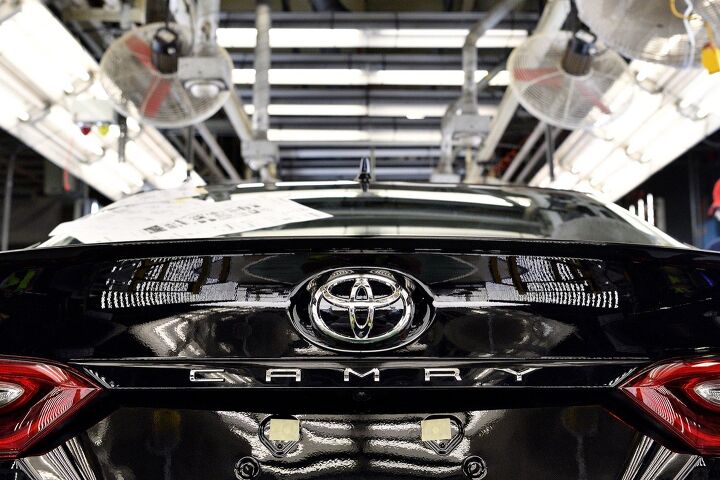#georgetown
Toyota Will Spend $374 Million on Five U.S. Plants - Think Hybrids and Camrys
Toyota announced yesterday that its plans to invest $10 billion in the United States, revealed earlier this year, will grow by another $374 million with big spending at five different factories in five different states.
Kentucky, Tennessee, West Virginia, Alabama, and Missouri will all benefit. Though it’s unlikely the investments will directly translate to much in the way of new employment — Toyota promises 50 new jobs in Alabama — Toyota says “these investments will help to ensure the stability of the plants’ employment levels in the future.”
At the core of the investments? Toyota is spending money to enable greater production of the new TNGA 2018 Toyota Camry’s 2.5-liter engines and hybrid transaxles. Why America? “The investment is part of our long-term commitment to build more vehicles and components in the markets in which we sell them.”
Toyota sells 200,000 vehicles per month in the United States.
All of the New 2018 Toyota Camrys Sold in America in July Were Japan Imports
We learned early in July that many of the early 2018 Toyota Camrys available in Toyota’s U.S. showrooms wouldn’t be built in Toyota’s Georgetown, Kentucky, assembly plant.
Through June, not a single one of the 2016 and 2017 Camrys sold in America were imported. But all of the 2018 Toyota Camrys sold in July came across the Pacific from Japan.
Granted, most of the Camrys leaving Toyota showrooms are still old new Camrys, not new new Camrys.
The Next Toyota Avalon Is TNGA, Assuming the Next Avalon Is
Stiffer structures, a lower center of gravity for improved handling, more shared components, and a 20-percent cost cut are all benefits of the Toyota New Global Architecture. Eventually, Toyota wants all of its front-wheel-drive vehicles to use TNGA as a starting point.
You first witnessed TNGA in the 2016 Toyota Prius, then in the 2018 Toyota C-HR, and most recently in the 2018 Toyota Camry that’s trickling into dealers now.
But beyond the ability to improve existing nameplates and spawn dramatically different new cars, TNGA is also intended to improve plant efficiency. Yet a massive shift at Toyota’s Georgetown, Kentucky assembly plant, detailed by Wards Auto, hasn’t yet resulted in the efficiency rewards.
“When we change over in the future with the Avalon, we’ll be able to pull that efficiency out of (the operation),” Toyota Motor Manufacturing Kentucky president Wil James told Wards.
Ah yes, Avalon. How could we forget?
Want a Truly Japanese 2018 Toyota Camry? Examine VINs Closely for the Next Few Months
As all-new 2018 Toyota Camrys begin to trickle into Toyota’s U.S. dealers over the coming weeks, take a close look at the VIN.
It’s viewable through the windshield on the driver’s side. See that first number? It’s likely a 4, which means this Camry was built in Georgetown, Kentucky.
But there’s a chance that the VIN on the new 2018 Camry sitting on your local Toyota dealer’s lot doesn’t begin with a number at all.
You’re looking at the once-coveted J-VIN. Ooh la la.
Toyota Truly Believes 2018 Camry Will Do For Midsize Sedans What Tacoma Did For Midsize Trucks; Kentucky Plant Employment At All-Time High
Excited at the prospect of an all-new midsize sedan despite a drastic decrease in demand for midsize sedans, Toyota is ramping up employment at the Camry’s assembly plant in Georgetown, Kentucky.
With 700 additional manufacturing workers helping to launch the 2018 Toyota Camry, employment at Toyota’s Kentucky facility grew to 8,000, more than at any point in the plant’s three-decade history.
Toyota also builds Avalons and Lexus ES350s in Georgetown. (The Venza, a former Georgetown wagon, is dead.) But it’s the Camry, especially this all-new 2018 Camry, that will bring glory to the Kentucky plant if glory can indeed be brought.
Jack Hollis, the Toyota division’s group vice president and general manager, strongly believes the Camry is the beginning of a pro-sedan wave in America. In an extended interview with Autoline, Hollis spoke highly of the 2018 Camry’s potential, and of the potential for the entire car sector once the Camry stimulates demand.
“I think you’re going to see the entire sedan market pick up,” Hollis told Autoline, before hedging only a bit. “We’ll see a year from now.”




















Recent Comments